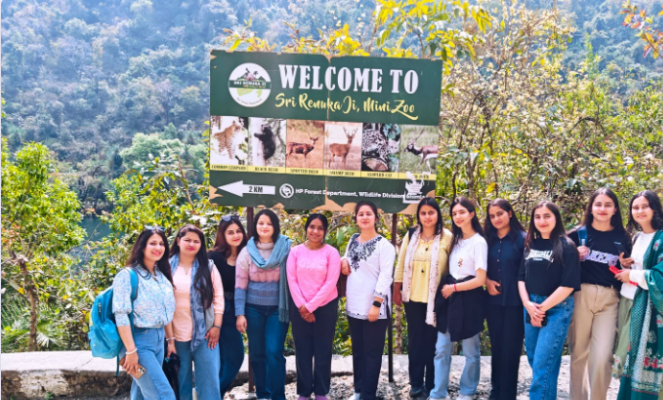Discovering the Rich Faunal Diversity of Himachal’s Largest Natural Lake
To foster hands-on learning beyond classrooms, the Department of Zoology organized an educational visit to the Renuka Ji Ramsar Wetland, a biodiversity hotspot in Himachal Pradesh. The trip aimed to help students explore the vibrant faunal diversity of both aquatic and terrestrial species in their natural habitats.
Sacred Serenity Meets Biodiversity
The educational journey began with a visit to the sacred Renuka Ji Temple, located amidst lush greenery. Following the temple visit, the students headed towards Renuka Lake, the largest natural lake in Himachal Pradesh, which also holds the prestigious Ramsar Wetland status for its ecological importance.
A Living Classroom – Wildlife Encounters
Accompanied by teachers Mr. Balbinder Singh and Dr. Preety Tomar, the group of 25 students explored the diverse ecosystems surrounding the lake. They walked through the Mini Zoo, observing a variety of animals including Ghoral, Kakkar, Chital, Hare, Black Bear, Leopard, Langur, Monkey. They also engaged in birdwatching and identification and spotting species like Pheasants, Partridges, Jungle Fowl, Parrots, as well as studying habits of Migratory Birds, Ducks, and more.
The serene lake also offered glimpses of aquatic life such as fish, tortoises, and a vibrant collection of butterflies fluttering around the wetland.
Learning Beyond Textbooks
The visit provided students with valuable exposure to ecological diversity, conservation importance, and the need to preserve wetland ecosystems. It was a perfect blend of education and adventure, leaving students enriched with knowledge and deeper respect for wildlife and nature.
Why Wetland Conservation Matters
Ramsar wetlands like Renuka Ji are crucial for maintaining biodiversity, regulating climate, and supporting wildlife habitats. Visits like these not only educate young minds but also inspire future conservationists to protect our natural treasures.














Add comment